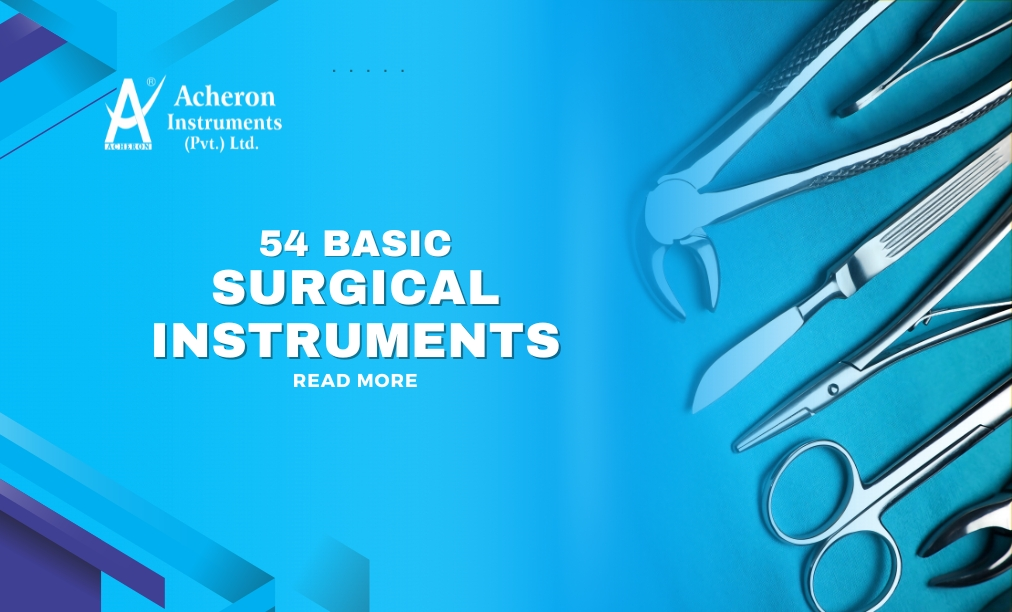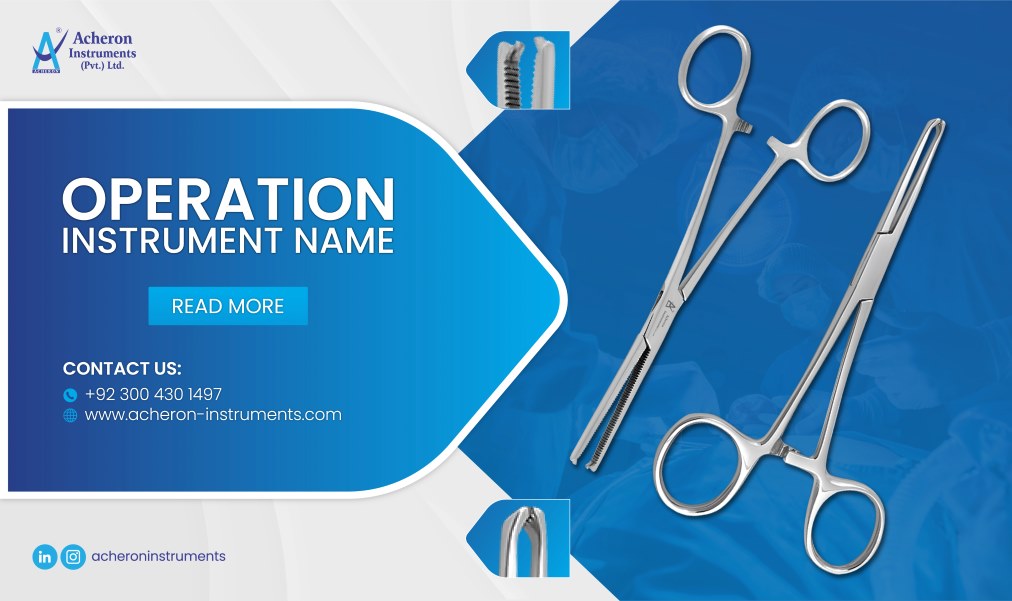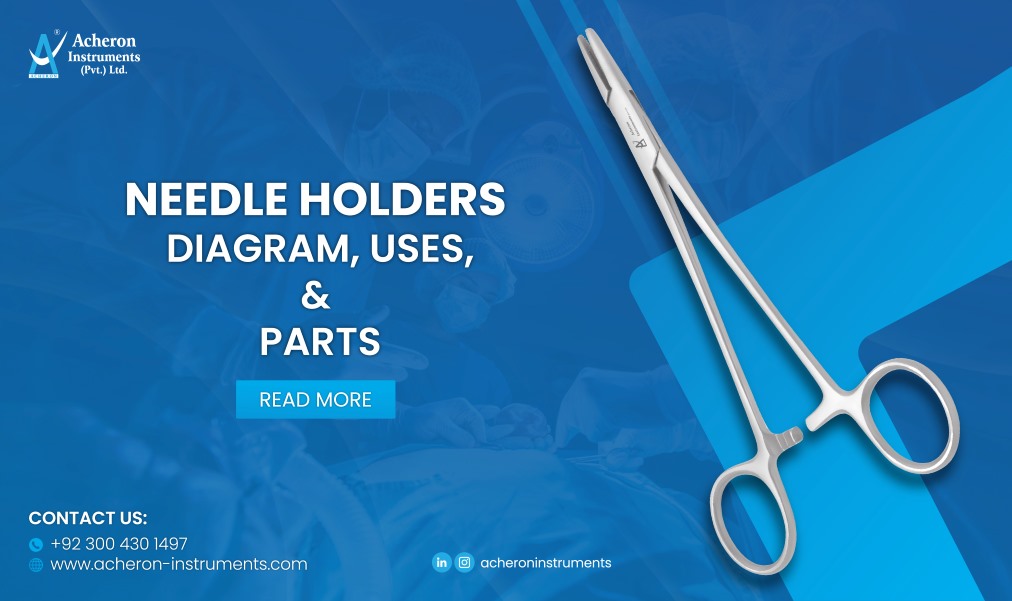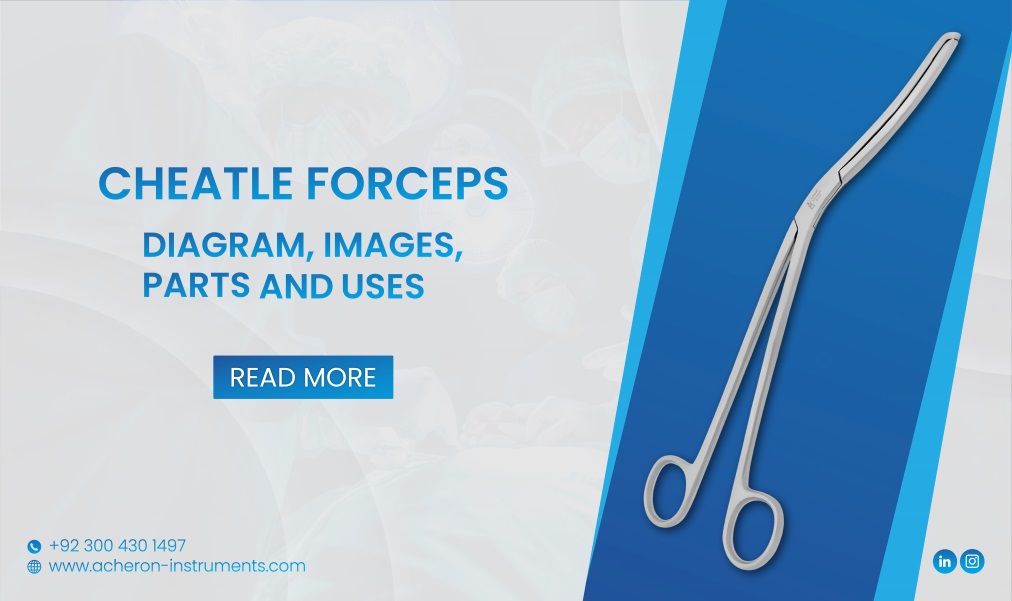Are you a healthcare practitioner who is looking for the basic surgical tools for your healthcare institution? Do you find it difficult to address which instruments you are going to need frequently in your operating rooms? Fret not! We have shortlisted 54 basic surgical instruments for you that must be a part of every operating room.
Whether it’s about a specialized surgical procedure or general surgery, there are a few basic surgical tools that are of utmost importance. Not only this, but these surgical tools enhance surgical precision, accuracy, and safety. Moreover, the medical field relies heavily on an array of these basic surgical tools as well as the skillful hands of the surgeons.
We will delve into a comprehensive guide on the basic surgical tools in this blog used in medical procedures. Let’s find out!

Common 54 Basic Surgical Instruments Names
|
Sr. No |
Name of Surgical Instruments |
Use in Medical Procedures |
|
1 |
Surgical Scissors |
For precise cutting |
|
2 |
Surgical knives |
For making deep and precise incisions |
|
3 |
Scalpels |
For initial incision during surgical processes |
|
4 |
Surgical Ronguers |
For the extraction of small bone fragments |
|
5 |
Forceps |
For holding and manipulation of tissues and organs |
|
6 |
Retractors |
For clear visualization |
|
7 |
Needle Holders |
For holding and manipulating needles |
|
8 |
Tissue Forceps |
For grasping and holding delicate tissues |
|
9 |
Trocar |
For drainage of fluids |
|
10 |
Bone Saw |
For cutting through the bones in orthopedic procedures |
|
11 |
Surgical Drill |
For drilling holes into bones during orthopedic surgeries |
|
12 |
Speculum |
For inspection of body cavities especially in gynecological procedures |
|
13 |
Curette |
For scraping and manipulation of soft tissues |
|
14 |
Clip applier |
For secure closure and ligature of blood vessels and other structures |
|
15 |
Stapler |
For closing and stealing tissue incisions |
|
16 |
Electrocautery |
For cutting, removal of tissues, and sealing of vessels |
|
17 |
Suture |
For stitching tissues or wounds together |
|
18 |
Bulldog Clamp |
For temporary closing of blood vessels |
|
19 |
Nasal Speculum |
For examination of nasal cavities and passages |
|
20 |
Anoscope |
For examination of the anus and rectum |
|
21 |
Tenotomy Scissors |
For cutting tendons |
|
22 |
Biopsy punch |
For obtaining tissue samples for diagnosis purposes |
|
23 |
Ribs spreader |
For separation and opening of ribs during thoracic surgeries |
|
24 |
Grafting Knife |
For cutting and harvesting thin layers of skin during transplantation |
|
25 |
Retinal Scissors |
For cutting and dissection of delicate eye tissues |
|
26 |
Ligature Carrier |
For passing and securing ligatures or sutures |
|
27 |
Spinal Needle |
For delivering anesthesia and fluid withdrawal |
|
28 |
Endoscope |
For visualization of the interior of hollow organs |
|
29 |
Gastroscope |
For examination of the abdominal interior |
|
30 |
Cannula |
For insertion and draining of fluids |
|
31 |
Ophthalmoscope |
For examination of internal eye structure |
|
32 |
Tonsillectomy |
For removal of tonsils |
|
33 |
Cystoscope |
For examination of bladder |
|
34 |
Bone Clamp |
For holding bone fragments |
|
35 |
Trocar |
For accessing space or cavity within the body |
|
36 |
Rib shear |
For cutting and removing parts of ribs |
|
37 |
Babcock forceps |
For grasping of delicate tissues |
|
38 |
Abdominal Retractor |
For examination of abdominal incision |
|
39 |
Vascular Clamp |
For blocking blood vessels during procedures |
|
40 |
Bronchoscope |
For examination of the airways of the lungs |
|
41 |
Dermal Curette |
For surgical removal of tissues and tumors from superficial skin |
|
42 |
Catheter |
For draining fluids from or injecting fluids into the body |
|
43 |
Myringotomy Knife |
For making a small incision in the eardrum during myringotomy |
|
44 |
Uterine Sound |
For measuring the depth of the uterus |
|
45 |
Thoracic Trocar |
For inserting test tubes during thoracic surgeries |
|
46 |
Episiotomy Scissors |
For making cuts during childbirth |
|
47 |
Tissue Scissors |
For cutting and dissection of delicate tissues |
|
48 |
Vein Stripper |
For treating varicose veins |
|
49 |
Hernia Clamp |
For creating a clear operative field to repair a hernia |
|
50 |
Endo-cervical curette |
For obtaining a sample of cells from the Endo-cervical canal |
|
51 |
Bone Chisel |
For cutting and shaping bones in orthopedic surgeries |
|
52 |
Hemostat |
For controlling bleeding during surgical procedures |
|
53 |
Suture passer |
For passage of sutures through tissues in minimally invasive procedures |
|
54 |
Dermatomes |
For cutting thin slices of skin during grafting procedures |
Common 54 basic surgical instruments names for every operating room
Surgical scissors
Scissors serve as versatile cutting tools that prove valuable in a variety of surgical procedures. Generally, these scissors consist of two opposing blades with sharp edges, which may be curved or straight. Moreover, surgical scissors are available in various forms. Some of these come with finer blades that are suitable for delicate dissection, while larger ones are effective for cutting tough tissues or sutures. Also, some examples of surgical scissors include Metzenbaum scissors, Potts Smith scissors, mayo scissors, etc.
Surgical knives
Surgical knives come into use when surgeons have to make deep and precise incisions. These tools feature sharp, pointed blades along with ergonomic handles that provide a controlled grip. Also, these knives are equipped with detachable blades for convenient replacement based on medical professionals' needs.
Mainly, surgical knives are valuable in procedures that require deep tissue access, such as organ resection or tumor removal.
Scalpels
A scalpel is a small, slender knife that comes into use for the initial incision at the onset of a surgical procedure. This surgical tool comprises a blade and a handle that provides surgeons with enhanced precision and cutting control. Also, the blades of scalpels vary in size and are designated by a specific blade number.
Sclalpels greatly come into use when surgeons have to make delicate cuts or incisions and create access points.
Surgical Ronguers
Rongeurs serve as sturdy surgical instruments designed for the extraction of small bone fragments or soft tissues during surgical procedures. These tools feature cup-shaped sharp tips that facilitate the surgeon in gripping and removing small pieces of bone or tissue. These tools are important in multiple surgical scenarios including neurosurgical, orthopedic as well as maxillofacial surgeries.
Forceps
Surgical forceps are incredible tools that must be present in every operating room. they are used to grasp, hold, or manipulate tissues, organs, or other objects.
Retractors
Surgical retractors are medical equipment used to hold back tissues and organs during surgical procedures, providing a clear view and access to the surgical site. Also, these tools hold the incisions open and expose the surgical area for better accessibility. Some examples include the Beckman retractor, Deaver retractor
Needle holders
Surgeons use this tool to hold needles and manipulate them for various medical tasks. These tools are a crucial part of any surgical kit and are used in multiple medical specialties. Some examples include Mayo Hegar needle holders, Crile wood needle holders, etc.
Tissue forceps
These tools are designed to grasp and hold delicate tissues without causing damage. Also, it features a tweezer-like design with two opposing blades that come in various sizes and shapes to suit different surgical scenarios. Some examples include Adson forceps, Debakey forceps, brown Adson forceps, etc.
Trocar
A trocar is a surgical tool with a sharply pointed end, that surgeons use to puncture the body wall in medical procedures such as laparoscopy. This enables access to the insertion of other instruments or the drainage of fluids.
Bone saw
This tool is mostly useful in orthopedic procedures to cut through the bones.
Surgical drill
This specialized tool is useful when surgeons have to drill holes into bones during various surgical procedures including orthopedic and neurosurgeries.
Speculum
The speculum is a great tool useful for examination of body cavities. A vaginal speculum is greatly useful in gynecological surgeries for inspecting the cervix area.
Curette
Curettes find application in exploring or scraping tissues, especially valuable in manipulating soft tissue. Moreover, they are available in diverse handle styles, featuring round or oval heads of different sizes.
Clip applier
A clip applier is a surgical tool utilized in procedures to securely close or ligate blood vessels, tissues, or other structures.
Stapler
The surgical staplers are metallic in nature and essential to close and seal tissue incisions. Also, these staplers are an alternative to traditional sutures for creating faster and more consistent closures.
Electrocautery
Electrocautery is a medical device that uses a high-frequency electrical current to cut, coagulate, or remove tissue during surgical procedures. Also, this device also allows surgeons to seal blood vessels to achieve hemostasis.
Suture
It is a medical device used to stitch together tissues or wound edges, promoting healing and closure.
Bulldog clamp
This is a surgical instrument that surgeons commonly use to temporarily occlude or close blood vessels during surgical procedures. Moreover, It has a spring-loaded mechanism that allows the clamp to grip onto the vessel. This in turn provides a secure closure without the need for continuous manual holding.
Nasal speculum
ENT surgeons make great use of this tool to examine nasal cavities and passages for making a diagnosis. It features two blades that can be adjusted to gently separate the nasal passages, allowing healthcare professionals to access and visualize the nasal cavity.
Anoscope
This medical device comes in handy when surgeons have to examine the rectum and anus area.
Tenotomy scissors
These specialized surgical scissors are designed for cutting tendons during surgical procedures. Also, they have a delicate and narrow profile, that makes them well-suited for precise and controlled cutting of tendons.
Biopsy punch
A biopsy punch is a medical tool that surgeons use to obtain tissue samples for diagnostic purposes. It comprises a circular, hollow blade that is useful to excise a small, cylindrical specimen from the body.
Rib spreader
A rib spreader, also known as a thoracic retractor, is useful to gently separate and hold open the ribs during thoracic (chest) surgeries. It features two or more blades that are adjustable to carefully spread the ribs apart. Thus, providing the surgeon with better visibility and access to the internal structures of the chest cavity. Also, this tool is greatly useful in open-heart surgery, lung surgery, and other thoracic interventions.
Grafting knife
These basic plastic surgery instruments are designed for the precise cutting and preparation of grafts in surgical procedures. Also, this tool is particularly useful in the field of dermatology or basic plastic surgery. Additionally, the knife typically has a fine, sharp blade that allows surgeons to create thin, precise grafts of skin or other tissues for transplantation.
Retinal scissors
Retinal scissors are specialized surgical scissors that are useful for delicate and precise cutting of tissues in the eye, particularly during ophthalmic surgeries involving the retina. Also. these scissors have small, fine blades that allow surgeons to make precise and controlled incisions in the retina or other eye structures.
Ligature Carrier
This surgical instrument is used to pass and secure ligatures or sutures around blood vessels or other anatomical structures during surgical procedures. It typically consists of an elongated slender tool with a mechanism for holding and maneuvering the ligature or suture material.
Spinal Needle
It is a thin, hollow needle with a sharp tip that is commonly useful during spinal procedures. This tool allows for the extraction of cerebrospinal fluid or the injection of medications or contrast agents during these procedures.
Endoscope
An endoscope is a medical device consisting of a long, flexible tube equipped with a camera and a light source at its tip. Surgeons use this tool to visualize and examine the interior of hollow organs, cavities, or passages within the body.
Gastroscope
This one is a type of endoscope that has a specific design for examining the interior of the stomach. Also, It is a flexible, tubular instrument with a light source and a camera at its tip. Thus, allowing healthcare specialists to visualize the lining of the stomach for diagnostic purposes.
Cannula
A cannula is a flexible, thin, or hollow instrument that surgeons insert into the body for various medical reasons. These are commonly used for the administration or withdrawal of fluids, as well as for accessing blood vessels or other body cavities. Moreover, they come in different designs and sizes depending on their intended use.
ophthalmoscope
This device comes into use to examine the interior structures of the eye. It consists of a light source and a set of lenses that allow for the visualization of the optic disc, retina, blood vessels, and other components of the eye's interior.
Tonsillectomy
This device comes into use when surgeons have to remove tonsils which are small masses of tissue located at the back of the throat.
cystoscope
This tool typically consists of a thin, flexible tube or rigid rod with a light source and a small camera at the end. Also, it can be inserted through the urethra into the bladder. This allows healthcare practitioners to examine the lining of the bladder for abnormalities, such as tumors, stones, or inflammation.
Bone clamp
This is an orthopedic device that is useful for holding bone fragments in place providing the surgeon with a stable environment for accurate and controlled manipulation.
Trocar
It is a useful medical device that comprises a sharp pointed shaft to puncture the body wall, allowing access to a cavity or space within the body.
Rib shear
A rib shear is a surgical tool specifically designed for cutting or removing sections of ribs during thoracic procedures.
Babcock forceps
These are a type of atraumatic, non-perforating surgical tools that grasp delicate or soft tissues during medical procedures. Also, they have a unique design, featuring a fenestrated, semi-circular shape with a smooth, atraumatic surface.
Abdominal retractor
This is a surgical instrument designed to hold back or retract the edges of an incision in the abdominal wall during various abdominal surgeries. This also provides the surgeon with a clear view and access to the internal organs.
Vascular Clamp
A vascular clamp is a surgical instrument used to temporarily occlude (block or close off) blood vessels during various surgical procedures.
Bronchoscope
This medical instrument is used for visualizing and examining the inside of the airways and lungs.
dermal curette
This medical instrument is useful for the surgical removal of superficial skin lesions or tissue. It typically comprises a loop-shaped or oval-shaped blade attached to a handle.
Catheter
A catheter is a flexible, hollow tube that comes into use for various medical purposes, including draining fluids from or
injecting fluids into the body.
Myringotomy Knife
This surgical instrument is specifically designed for making a small incision in the eardrum (tympanic membrane) during a procedure called myringotomy.
Uterine Sound
This device is useful when surgeons have to measure the depth of the uterus
Thoracic Trocar
This surgical tool is used to insert chest tubes during thoracic surgeries
Episiotomy Scissors
This tool is used to perform an episiotomy to make an incision during childbirth
Tissue Scissors
These amazing scissors come into use when surgeons have to cut and dissect delicate tissues
Vein Stripper
This is a medical device used in surgical procedures to treat varicose veins which are enlarged, twisted veins that often occur in the legs due to weakened vein walls and valves.
Hernia clamp
This tool is useful for repairing hernias to handle tissues and create a clear operative field.
Endocervical Curette
This is a medical instrument used for obtaining a sample of cells from the endocervical canal, which is the part of the cervix closest to the uterus.
Bone Chisel
This surgical tool has an ideal design for cutting or shaping bone during orthopedic and reconstructive surgeries.
Hemostat
A hemostat is a surgical instrument that surgeons use to control bleeding by clamping blood vessels or tissue.
Suture Passer
Surgeons use this tool during different surgical procedures to facilitate the passage of sutures through tissues, particularly in arthroscopic or minimally invasive surgeries.
Dermatomes
Surgeons use this tool during grafting procedures to precisely cut thin slices of skin
Wrap up
Surgical instruments are an integral part of every operating room. however, you must choose the right surgical tool for your specific surgical procedure. This is important because each tool has its distinctive characteristics and should be used for the intended purpose only.
Apart from this, one of the most important points you need to consider is getting the best quality surgical tools for your operating rooms. A high-quality tool will not only last longer in your operating rooms but will also require fewer repairs or replacements in the long run,
Looking for high-quality surgical instruments? Look no further. We at Acheron Instruments offer high-grade German stainless steel material surgical tools that are durable, robust, reusable, and easily sterilizable. Also, our products are available at the most reasonable prices without compromising on quality.
FAQs related to 54 basic surgical instruments
What is the material used for Acheron Instruments’ surgical tools?
Our surgical tools are crafted from German-grade stainless steel. This high-quality material is known for its corrosion resistance, ease of cleaning, and capacity to endure repeated sterilization processes. These qualities guarantee the instrument's long-lasting durability.
Why buy from Acheron Instruments?
We have gained trust across the globe with our impeccable customer service and high-quality surgical tools. Our well-reputed company is globally known for its unparalleled expertise and trustworthiness.
How to order from Acheron Instruments?
You can contact us via email or the contact number given on our page. Or simply visit our website for further instance. Our representative will answer all your queries shortly.








